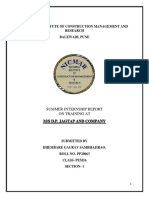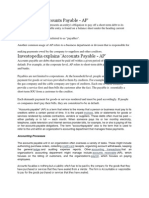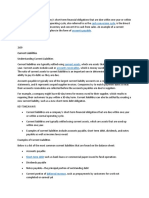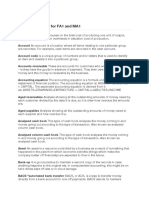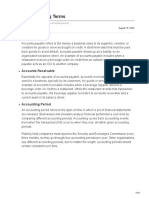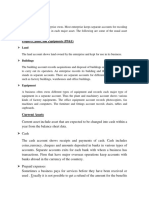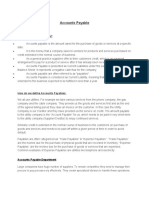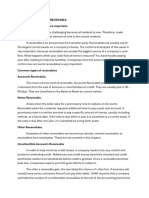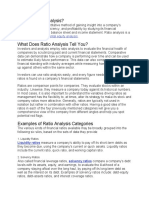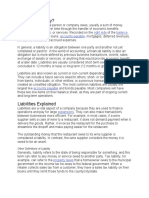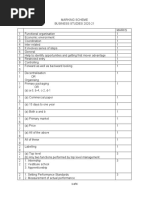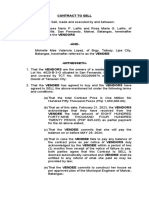0 ratings0% found this document useful (0 votes)
51 viewsWhat Is Accounts Receivable
What Is Accounts Receivable
Uploaded by
Darlene SarcinoAccounts receivable (AR) refers to money owed to a company by customers who have purchased goods or services on credit but not yet paid for them. AR is recorded as a current asset on the balance sheet. It represents the outstanding invoices a company is owed and is a line of credit extended to customers who are expected to pay within a short time period, usually a year or less. Accounts receivable provide short-term financing to customers and allow companies to make sales before receiving payment.
Copyright:
© All Rights Reserved
Available Formats
Download as DOCX, PDF, TXT or read online from Scribd
What Is Accounts Receivable
What Is Accounts Receivable
Uploaded by
Darlene Sarcino0 ratings0% found this document useful (0 votes)
51 views2 pagesAccounts receivable (AR) refers to money owed to a company by customers who have purchased goods or services on credit but not yet paid for them. AR is recorded as a current asset on the balance sheet. It represents the outstanding invoices a company is owed and is a line of credit extended to customers who are expected to pay within a short time period, usually a year or less. Accounts receivable provide short-term financing to customers and allow companies to make sales before receiving payment.
Copyright
© © All Rights Reserved
Available Formats
DOCX, PDF, TXT or read online from Scribd
Share this document
Did you find this document useful?
Is this content inappropriate?
Accounts receivable (AR) refers to money owed to a company by customers who have purchased goods or services on credit but not yet paid for them. AR is recorded as a current asset on the balance sheet. It represents the outstanding invoices a company is owed and is a line of credit extended to customers who are expected to pay within a short time period, usually a year or less. Accounts receivable provide short-term financing to customers and allow companies to make sales before receiving payment.
Copyright:
© All Rights Reserved
Available Formats
Download as DOCX, PDF, TXT or read online from Scribd
Download as docx, pdf, or txt
0 ratings0% found this document useful (0 votes)
51 views2 pagesWhat Is Accounts Receivable
What Is Accounts Receivable
Uploaded by
Darlene SarcinoAccounts receivable (AR) refers to money owed to a company by customers who have purchased goods or services on credit but not yet paid for them. AR is recorded as a current asset on the balance sheet. It represents the outstanding invoices a company is owed and is a line of credit extended to customers who are expected to pay within a short time period, usually a year or less. Accounts receivable provide short-term financing to customers and allow companies to make sales before receiving payment.
Copyright:
© All Rights Reserved
Available Formats
Download as DOCX, PDF, TXT or read online from Scribd
Download as docx, pdf, or txt
You are on page 1of 2
What Is Accounts Receivable (AR)?
Accounts receivable (AR) is the balance of money due to a firm for goods or
services delivered or used but not yet paid for by customers. Accounts
receivables are listed on the balance sheet as a current asset. AR is any amount
of money owed by customers for purchases made on credit.
Understanding Accounts Receivable (AR)
Accounts receivable refers to the outstanding invoices a company has or the
money clients owe the company. The phrase refers to accounts a business has
the right to receive because it has delivered a product or service. Accounts
receivable, or receivables represent a line of credit extended by a company and
normally have terms that require payments due within a relatively short time
period. It typically ranges from a few days to a fiscal or calendar year.
Companies record accounts receivable as assets on their balance sheets since
there is a legal obligation for the customer to pay the debt. Furthermore,
accounts receivable are current assets, meaning the account balance is due from
the debtor in one year or less. If a company has receivables, this means it has
made a sale on credit but has yet to collect the money from the purchaser.
Essentially, the company has accepted a short-term IOU from its client.
Accounts Receivables vs. Accounts Payable
When a company owes debts to its suppliers or other parties, these are accounts
payable. Accounts payable are the opposite of accounts receivable. To illustrate,
imagine Company A cleans Company B's carpets and sends a bill for the
services. Company B owes them money, so it records the invoice in its accounts
payable column. Company A is waiting to receive the money, so it records the bill
in its accounts receivable column.
Benefits of Accounts Receivable
Accounts receivable is an important aspect of a businesses' fundamental
analysis. Accounts receivable is a current asset so it measures a company's
liquidity or ability to cover short-term obligations without additional cash flows.
Fundamental analysts often evaluate accounts receivable in the context of
turnover, also known as accounts receivable turnover ratio, which measures the
number of times a company has collected on its accounts receivable balance
during an accounting period. Further analysis would include days sales
outstanding analysis, which measures the average collection period for a firm's
receivables balance over a specified period.
Example of Accounts Receivable
An example of accounts receivable includes an electric company that bills its
clients after the clients received the electricity. The electric company records an
account receivable for unpaid invoices as it waits for its customers to pay their
bills.
Most companies operate by allowing a portion of their sales to be on credit.
Sometimes, businesses offer this credit to frequent or special customers that
receive periodic invoices. The practice allows customers to avoid the hassle of
physically making payments as each transaction occurs. In other cases,
businesses routinely offer all of their clients the ability to pay after receiving the
service.
You might also like
- Highway Construction Internship ReportDocument33 pagesHighway Construction Internship ReportGaurav Dhembare85% (61)
- Sabp-G-017 (2016)Document19 pagesSabp-G-017 (2016)tromix100% (2)
- ResMed-VPAP-Combined Service-Manual PDFDocument61 pagesResMed-VPAP-Combined Service-Manual PDFjosers123100% (1)
- Test Sample 3 Law On SalesDocument10 pagesTest Sample 3 Law On SalesDarlene SarcinoNo ratings yet
- Test Sample 1 Law (Oblicon)Document4 pagesTest Sample 1 Law (Oblicon)Darlene Sarcino100% (2)
- What Is Accounts Receivable (AR) ?Document3 pagesWhat Is Accounts Receivable (AR) ?Sheila Mae AramanNo ratings yet
- What Is Accounts Receivable (AR) ?Document2 pagesWhat Is Accounts Receivable (AR) ?Art B. EnriquezNo ratings yet
- Understanding ARDocument2 pagesUnderstanding ARJann Vic SalesNo ratings yet
- What Are Accounts Payable (AP) ?Document3 pagesWhat Are Accounts Payable (AP) ?Art B. EnriquezNo ratings yet
- Accounts Payble and Receivable.Document8 pagesAccounts Payble and Receivable.haris123786No ratings yet
- What Are Accounts Receivable (AR) ?Document3 pagesWhat Are Accounts Receivable (AR) ?Sheila Mae AramanNo ratings yet
- Cash Conversion Cycle Accounts Payable: Current LiabilitiesDocument3 pagesCash Conversion Cycle Accounts Payable: Current LiabilitiesEllaine Pearl AlmillaNo ratings yet
- Glossary of Terms For FA1 and MA1Document15 pagesGlossary of Terms For FA1 and MA1FuckuscribdNo ratings yet
- Glossary of Key Accounting Terms This Glossary Contains Most ofDocument20 pagesGlossary of Key Accounting Terms This Glossary Contains Most ofNguyen_nhung1105No ratings yet
- Glossary of Terms For FA1 and MA1 FINAL 1Document13 pagesGlossary of Terms For FA1 and MA1 FINAL 1ssmaham4No ratings yet
- Accounts Payable Module-2Document3 pagesAccounts Payable Module-2by ScribdNo ratings yet
- Assignment of Financial ManagementDocument6 pagesAssignment of Financial ManagementNavneet KaurNo ratings yet
- Lesson 7 TextbookDocument57 pagesLesson 7 TextbookSalima100% (1)
- Accounts ReceivableDocument3 pagesAccounts ReceivableVishal DahiwalNo ratings yet
- Definitions of Common Accounting TermsDocument6 pagesDefinitions of Common Accounting TermsAliya SaeedNo ratings yet
- AccountsDocument5 pagesAccountsAlyssa CasimiroNo ratings yet
- Accounting 101 - Basic Accounting TermsDocument10 pagesAccounting 101 - Basic Accounting TermsNoah HNo ratings yet
- Accounts PayableDocument4 pagesAccounts PayableTina ParkNo ratings yet
- Accounts Payable ExplanationDocument14 pagesAccounts Payable ExplanationBony ThomasNo ratings yet
- C PPPPP P PPP PPPPPPP: P P P P PDocument7 pagesC PPPPP P PPP PPPPPPP: P P P P PKaustubh HarneNo ratings yet
- Accounts Payable ExplanationDocument14 pagesAccounts Payable Explanationdario.ramirezNo ratings yet
- AR Accounts ReceivableDocument3 pagesAR Accounts ReceivableImran HassanNo ratings yet
- Accounts PaybleDocument3 pagesAccounts Paybleaccounts1No ratings yet
- RECEIVABLESDocument4 pagesRECEIVABLESCyril DE LA VEGANo ratings yet
- Objective tally accounting qnsDocument14 pagesObjective tally accounting qnsjamielanannungiNo ratings yet
- Account Titles and ExplanationDocument4 pagesAccount Titles and ExplanationKaye VillaflorNo ratings yet
- Assorted GlossaryDocument21 pagesAssorted Glossarydarklem0nzestNo ratings yet
- Unit 6 Audit of LiabilitiesDocument6 pagesUnit 6 Audit of Liabilitiessolomon adamuNo ratings yet
- What Is Accounts Payable (AP) ?: General LedgerDocument3 pagesWhat Is Accounts Payable (AP) ?: General LedgerDarlene SarcinoNo ratings yet
- REC2Document2 pagesREC2Zyrene YanezNo ratings yet
- Asset Account: Property, Plant, and Equipments (PP&E)Document4 pagesAsset Account: Property, Plant, and Equipments (PP&E)Ahsan AliNo ratings yet
- Current Liability DefinitionDocument2 pagesCurrent Liability DefinitionRhea Mae AmitNo ratings yet
- Accounting NotesDocument3 pagesAccounting NotesVanya AvramovaNo ratings yet
- Understand Basic Accounting TermsDocument5 pagesUnderstand Basic Accounting Termsabu taherNo ratings yet
- AssetsDocument7 pagesAssetsarchie demesaNo ratings yet
- What Is Accounts Payable?Document3 pagesWhat Is Accounts Payable?D Suresh BabuNo ratings yet
- 02 Handout 1Document6 pages02 Handout 1Stacy Anne LucidoNo ratings yet
- ACCOUNT-RECEIVABLE-_NOTES-RECEIVABLEDocument27 pagesACCOUNT-RECEIVABLE-_NOTES-RECEIVABLEgraceannmanto154No ratings yet
- REC3Document4 pagesREC3Zyrene YanezNo ratings yet
- Journal EntriesDocument8 pagesJournal Entriesrayyan64003No ratings yet
- Document1ASSIGNMENT 1 FINACIAL ACCOUNTINGDocument4 pagesDocument1ASSIGNMENT 1 FINACIAL ACCOUNTINGBridget MulaishiNo ratings yet
- Actg 1 Module 3Document5 pagesActg 1 Module 3Mae BertilloNo ratings yet
- Basic Accounting TermsDocument6 pagesBasic Accounting TermsTiffany VinzonNo ratings yet
- (ACCT 317) Chapter 8 - Reporting and Analyzing ReceivablesDocument1 page(ACCT 317) Chapter 8 - Reporting and Analyzing Receivablesp.a.No ratings yet
- Menagement of ReceiveableDocument5 pagesMenagement of ReceiveableMuhammad Furqan AkramNo ratings yet
- Accounts ReceivableDocument14 pagesAccounts Receivableaccesstariq100% (3)
- All Basic Terms of AccountingDocument20 pagesAll Basic Terms of AccountingpoornapavanNo ratings yet
- Act 2100 LectureDocument39 pagesAct 2100 Lecturekeyanna gilletteNo ratings yet
- Balance Sheet AccountingDocument7 pagesBalance Sheet AccountingGauravNo ratings yet
- Unit 5-Financial Statement AnalysisDocument15 pagesUnit 5-Financial Statement AnalysisBorisNo ratings yet
- BUSINESS FINANCE - Activity 3Document1 pageBUSINESS FINANCE - Activity 3Airish PascualNo ratings yet
- Introduction To AccountingDocument14 pagesIntroduction To AccountingAAr MahadevnNo ratings yet
- Accounts and Notes ReceivableDocument2 pagesAccounts and Notes ReceivableJosh BreciaNo ratings yet
- Working Capital ManagementDocument4 pagesWorking Capital ManagementFabia ArshadNo ratings yet
- Order To Cash - Accounts ReceivableDocument13 pagesOrder To Cash - Accounts Receivablekarpit9856No ratings yet
- Glossary of Accounting Terms Peter BaskervilleDocument12 pagesGlossary of Accounting Terms Peter BaskervilleDana NevelicicoNo ratings yet
- Basic BookkeepingDocument80 pagesBasic BookkeepingCharity CotejoNo ratings yet
- Accounting Terms A Quick Reference GuideDocument9 pagesAccounting Terms A Quick Reference GuideShreekumarNo ratings yet
- Accounting DataDocument17 pagesAccounting Datalunatic bullNo ratings yet
- What Is Return On InvestmentDocument3 pagesWhat Is Return On InvestmentDarlene SarcinoNo ratings yet
- What Is The Difference Between An Adjunct Account and A Contra AccountDocument1 pageWhat Is The Difference Between An Adjunct Account and A Contra AccountDarlene SarcinoNo ratings yet
- What Is The Difference Between Notes Payable and Accounts PayableDocument2 pagesWhat Is The Difference Between Notes Payable and Accounts PayableDarlene SarcinoNo ratings yet
- What Is The Solvency RatioDocument2 pagesWhat Is The Solvency RatioDarlene SarcinoNo ratings yet
- What Is Working Capital TurnoverDocument2 pagesWhat Is Working Capital TurnoverDarlene SarcinoNo ratings yet
- What Is Return On AssetsDocument2 pagesWhat Is Return On AssetsDarlene SarcinoNo ratings yet
- What Is Inventory TurnoverDocument2 pagesWhat Is Inventory TurnoverDarlene SarcinoNo ratings yet
- What Is An Asset?: Economic ValueDocument2 pagesWhat Is An Asset?: Economic ValueDarlene SarcinoNo ratings yet
- What Is Ratio AnalysisDocument2 pagesWhat Is Ratio AnalysisDarlene SarcinoNo ratings yet
- What Is Equity AccountingDocument2 pagesWhat Is Equity AccountingDarlene SarcinoNo ratings yet
- What Is A Liability?: Right Side Balance Sheet Accounts PayableDocument3 pagesWhat Is A Liability?: Right Side Balance Sheet Accounts PayableDarlene SarcinoNo ratings yet
- What Is Accounts Payable (AP) ?: General LedgerDocument3 pagesWhat Is Accounts Payable (AP) ?: General LedgerDarlene SarcinoNo ratings yet
- What Do Efficiency Ratios MeasureDocument2 pagesWhat Do Efficiency Ratios MeasureDarlene SarcinoNo ratings yet
- What Is Property, Plant, and Equipment - PP&E?: EquityDocument2 pagesWhat Is Property, Plant, and Equipment - PP&E?: EquityDarlene SarcinoNo ratings yet
- What Is Accounts Receivable TurnoverDocument4 pagesWhat Is Accounts Receivable TurnoverDarlene SarcinoNo ratings yet
- What Are Profitability RatiosDocument2 pagesWhat Are Profitability RatiosDarlene SarcinoNo ratings yet
- What Are Bonds PayableDocument1 pageWhat Are Bonds PayableDarlene SarcinoNo ratings yet
- What Is A StockDocument2 pagesWhat Is A StockDarlene SarcinoNo ratings yet
- What Is A PatentDocument2 pagesWhat Is A PatentDarlene SarcinoNo ratings yet
- What Is A Coverage RatioDocument2 pagesWhat Is A Coverage RatioDarlene SarcinoNo ratings yet
- Market Prospect RatiosDocument4 pagesMarket Prospect RatiosDarlene SarcinoNo ratings yet
- What Are Liquidity RatiosDocument2 pagesWhat Are Liquidity RatiosDarlene SarcinoNo ratings yet
- Financial Accounting and Reporting NotesDocument6 pagesFinancial Accounting and Reporting NotesDarlene SarcinoNo ratings yet
- What Are Notes ReceivableDocument2 pagesWhat Are Notes ReceivableDarlene SarcinoNo ratings yet
- What Is A PartnershipDocument2 pagesWhat Is A PartnershipDarlene SarcinoNo ratings yet
- Test Sample 2 Law (Oblicon)Document15 pagesTest Sample 2 Law (Oblicon)Darlene SarcinoNo ratings yet
- Applied Auditing: Chapter 5 Cash and Accrual BasisDocument5 pagesApplied Auditing: Chapter 5 Cash and Accrual BasisDarlene SarcinoNo ratings yet
- Actual Cost Accounting Records Variances: Standard Costing OverviewDocument3 pagesActual Cost Accounting Records Variances: Standard Costing OverviewDarlene SarcinoNo ratings yet
- Morbi ReportDocument15 pagesMorbi Reportmeetkalola18No ratings yet
- Normas DVS PDFDocument11 pagesNormas DVS PDFrodrigo diaz poblete100% (1)
- Bloomberg 27-Inch Flat Panel Display BFP200-27 FixedDocument6 pagesBloomberg 27-Inch Flat Panel Display BFP200-27 Fixedanon_45433537No ratings yet
- (B-0550) Pathology UnitDocument44 pages(B-0550) Pathology UnitAhmad Gamal Elden MAhanyNo ratings yet
- Navigation in The Enterprise Portal and Business PackagesDocument64 pagesNavigation in The Enterprise Portal and Business PackagesAnonymous 3ZvXNhYNo ratings yet
- International Logistics Manager Job DescriptionDocument2 pagesInternational Logistics Manager Job DescriptionSufiyan JayaNo ratings yet
- Marking Scheme Business Studies Preboard 2020-21Document4 pagesMarking Scheme Business Studies Preboard 2020-21Joanna GarciaNo ratings yet
- 3GPP TS 22.261Document73 pages3GPP TS 22.261bhushan7408No ratings yet
- Career Planning and Decision MakingDocument19 pagesCareer Planning and Decision MakingConnie LopicoNo ratings yet
- CTOOD CO1 CO2 NotesDocument173 pagesCTOOD CO1 CO2 Noteskalyan100% (1)
- Intern Schedule Template 2022Document3 pagesIntern Schedule Template 2022HRteamNo ratings yet
- Onelink Tickets Solved by HourDocument2 pagesOnelink Tickets Solved by HourJader Guitierrez MontesNo ratings yet
- Introduction To ANSYS Mechanical (2D)Document19 pagesIntroduction To ANSYS Mechanical (2D)Mi BoNo ratings yet
- Amity School of Business: Subject Code - MGMT 108 Psda - 1 Topic - Develop A Code of Ethics For A Specific IndustryDocument7 pagesAmity School of Business: Subject Code - MGMT 108 Psda - 1 Topic - Develop A Code of Ethics For A Specific IndustryAmanNo ratings yet
- Contract To Sell-LaiñoDocument2 pagesContract To Sell-LaiñoPhilip UlepNo ratings yet
- Uk Dcam 14 Point Analysis BrochureDocument2 pagesUk Dcam 14 Point Analysis BrochureAbdullahNo ratings yet
- University of Nottingham Dissertation LibraryDocument8 pagesUniversity of Nottingham Dissertation LibraryPaperWritingHelpUK100% (1)
- POLQA 2015 (V2.4) Investigated: - Technical White PaperDocument11 pagesPOLQA 2015 (V2.4) Investigated: - Technical White PaperHamza BouchebbahNo ratings yet
- Bus Part B1P ResourceBank Photocopiables U2Document2 pagesBus Part B1P ResourceBank Photocopiables U2Duong Le Tu UyenNo ratings yet
- PLC ReviewerDocument5 pagesPLC Reviewer21-09696No ratings yet
- Change Management Assignment-CompleteDocument11 pagesChange Management Assignment-CompleteMphatso kambanizitheNo ratings yet
- Lect13 Approaches For Test Data GenerationDocument4 pagesLect13 Approaches For Test Data GenerationRavindra KumarNo ratings yet
- 2.4.10-19-Ha-Solar Energy For Traffic LightsDocument8 pages2.4.10-19-Ha-Solar Energy For Traffic LightsGokul SNo ratings yet
- 1902-0213 - en TIGHTENING TORQUES FOR TYPE 4 ENGINESDocument28 pages1902-0213 - en TIGHTENING TORQUES FOR TYPE 4 ENGINESLuis PupialesNo ratings yet
- Factors Affecting The Adoption of Performance Audit in Public Universities in UgandaDocument10 pagesFactors Affecting The Adoption of Performance Audit in Public Universities in UgandaInternational Journal of Innovative Science and Research TechnologyNo ratings yet
- Chapter-123 Manuscript 2Document25 pagesChapter-123 Manuscript 2joanamagnaye7No ratings yet
